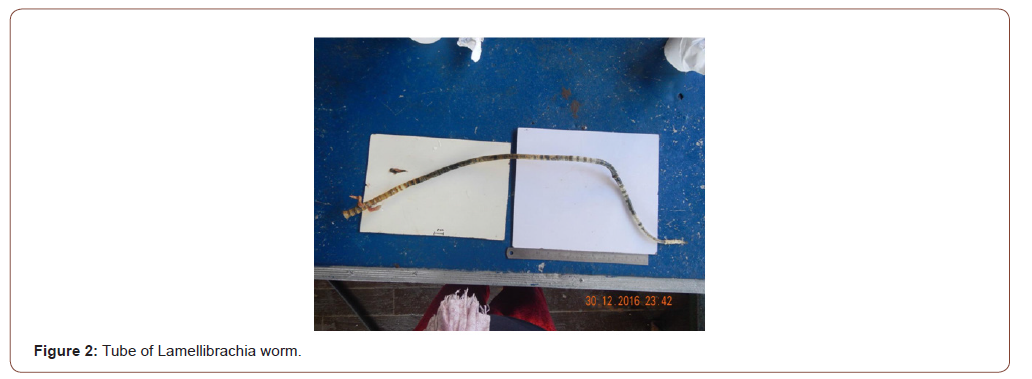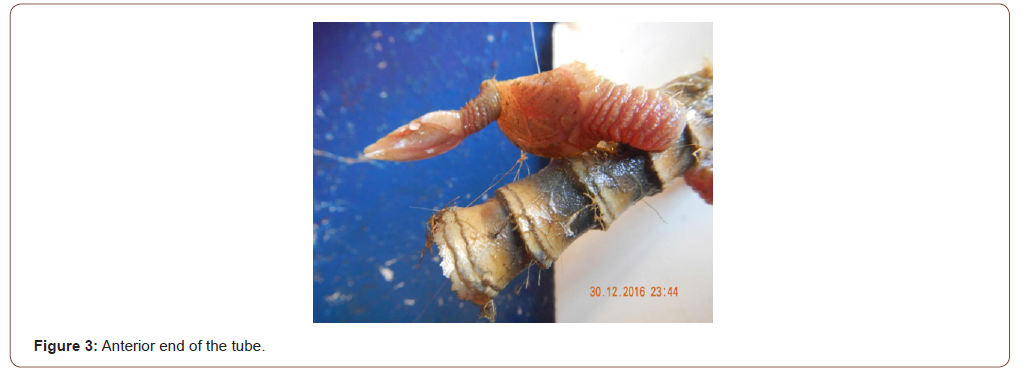 Research Article
Research Article
Report of Lamellibrachia Worm Tube from off Northwestern Andaman Island
Mohan PM, Department of Ocean Studies and Marine Biology, Pondicherry University Off-Campus, Port Blair – 744112, Andaman and Nicobar Islands, India.
Received Date: November 26, 2020; Published Date: December 16, 2020
Abstract
The Lamellibrachia worm is a gutless worm, the worm producing such a long tube about more than 1m, made up of the hard materials of proteinaceous compounds. They live as a chemoautotrophic and often found in the cold seep environments ecosystem, which acts as a gas reservoir (Hydrogen Sulfide). It has especially exhibited a rich source of Methane. Under the INDOBIS program on the benthic faunal survey (During the FORV Sagar Sampada 355 cruise), found thirty-five cm of animal less tube on the western side dredge operation of the Andaman Islands. Identifying the Lamellibrachia worm tube from off Northern Andaman Island suggested that this region may contain a cold seep ecosystem. This study reveals that the Lamellibrachia tube has found in the Andaman region and reported for the first time.
Introduction
The Ocean is a dynamic ecosystem for its diversity and abundance of flora and fauna. It has representatives of all the fauna groups from intertidal to deep-sea regions, i.e., from microorganisms to mammals. The near shore environment has been well studied worldwide than deep-sea and its differential features like Sea Mount, Deep Sea Trench, Mid Oceanic Ridges, Hydrothermal Vent, and Cold Seep environment. So, marine biology is necessary to understand the Ocean’s different features and its importance regarding biodiversity, geological activities, and the system’s chemistry to understand the resources and other novelties. However, the fluids come from the bottom of the ocean floor, and the process called cold seep or Methane seep, or sulfide seeps due to the higher availability of these compounds in the releasing fluids. Especially in the continent’s active and passive margins, this natural event often has abyssal and hadal depths [1]. These seep fluids are physically different from the ambient water where they act [2]. Wherever the seeps have occurred in the active or passive margins that the area may have the gas hydrate and oil reservoirs are possible (e.g., the Gulf of Guinea and the Gulf of Mexico, etc.) [1,3- 5]. It is also rich in methane and hydrogen sulfide, which is purely originated by the associated bacteria of this seep environment, and those compounds are also called reduced chemical compounds [4]. The existing biological system of cold seeps is closely similar to hydrothermal vent, especially species concerned taxonomically. The organisms are living in this environment mainly depend on the chemicals (Methane and Sulfide) for their respiration and energy [6]. However, this seep environment’s chemosynthetic biological system has provided an excellent productive climate as biologically diverse and vital natural resources. The cold seep environment found from 30 various locations of the World Oceans is also from the passive and active margins of the continent [1,7-9] had discussed in his article that the cold seeps community structure of the Gulf of Mexico and described details of the biogeography of cold-seep sites in the World Ocean and the biological communities. The cold seep environment’s organisms have a substantial economic value due to its unique adaptations, especially the sulfide deposit environment has high cost due to the availability of costly metal Gold [10,11]. However, a recent significant contribution to the active methane ecosystem’s documentation on the eastern Indian coast (Krishna- Godavari Basin) by CSIR National Institute of Oceanography, Goa, India [12]. The Andaman and Nicobar Islands and the Andaman Sea are present in the Northern Indian Ocean’s active margin. These Islands located at the junction of the Indo-Australian active plate. An oblique convergent margin of northeastern moving Australian or Indian plate and nearly stagnant Eurasian or Southeast Asian plate has provided the youngest marginal sea called Andaman Sea [13]. It has several exciting features [14,15] in that they are volcanic Islands (Barren and Narcondam), invisible underwater Bank, Seamount complexes (Alcock and Sewell), Nicobar Deep, Back arc Basin, and Central Andaman Trough, etc. [16] reported that the Andaman and Nicobar Islands’ faunal-rich marine environments are still unrevealed. The present study’s objective was to investigate the wealth of deep-sea benthic diversity off east and west of the Andaman Islands. This study has revealed cold seep associated tube worm Lamellibrachia sp. is one of the Andaman Sea’s unrevealed biological property.
Methodology
To study the diversity and distribution of deep-sea benthic macrofauna, the western and eastern side of Little Andaman to North Andaman, the expedition was made by Central Marine Living Resources and Ecology (CMLRE) under the Ministry of Earth Sciences (MoES), Cochin during the period between 22nd December 2016 to 03rd January 2017, through the Fishery and Oceanography Research Vessel, FORV Sagar Sampada (SS-355). The bottom trawl (A Standard Net HOT Model) and bottom dredge (Rectangular Stainless Steel Frame Dredger) operation carried 10 locations to collect the benthic fauna. The present study material from the latitude 13°19.490’N to 13°12.736’ N and longitude 092°23.656’ E to 092°29.197’ E. Collected and used for this presentation.
Result and Discussion
The collected dredge sample was analyzed and found a 35-centimeter-long tube (Plate 1) from the water depth of 535 m. The identified tube has a Lamellibrachia shell based on the pipe’s character, which had overlapped segments. Generally, the Lamellibrachia worms are the only life form present in the cold seep, sulfide-rich or methane-rich environment of active or passive ocean floor margins [1,10,11]. Therefore, wherever this life form is present, those areas may have the gas hydrate and oil reservoirs are possible (e.g., The Gulf of Guinea and The Gulf of Mexico. etc.) [1,3- 5]. Based on the literature [4], the identified worm tube suggested that the present study area belongs to the cold seep’s environment. Further, the location it has specified is also an active margin. So, this worm tube finding suggested that the Andaman region’s active margin may contain the gas hydrate or Methane or cold seeps (Figures 1-5).





Conclusion
This novel finding of the Lamellichibrachia worm tube from the Andaman region indicates that significant oil or methane resources may be available in this region. This study has suggested that the scientist from biological and geochemical sciences makes further investigation to quantify the available sources with more supportive evidence.
Acknowledgment
The authors thank the Captain and Crew members of the FORV Sagar Sampada (Cruise No. SS-355) for collecting samples from one of the most challenging terrains of the sea bottom. They also thank The Director, CMLRE, MoES for extending the permission to participate in this cruise. The authors also acknowledged the facility provided for this work by Pondicherry University and their authorities.
Conflict of Interest
No conflict of interest.
References
- Olu JK, Sibuet IM, Harmegnies F, Foucher JP, Fiala-Mi (1996) Spatial distribution of diverse cold seep communities living on various diapiric structures of southern Barbados prism. Progress in Oceanography 38: 347-376.
- Levin LA (2005) Ecology of cold seep sediments: Interactions of fauna with flow, chemistry and microbes. Oceanography and Marine Biology - an Annual Review 43. 43(Gibson RN, Atkinson RJA, Gordon JDM, Eds.) :1-46
- Desbruyeres D, Hashimoto J, Fabri M (2007) Composition and Biogeography of the vent communities in Western Pacific Back-Arc Basins. Geophysical Monograph Series-166 Americal Geophysical Union pp. 215-234.
- Vanreusel A, Andersen AC, je Boetius A, Connelly D, Cunha MR, et al. (2009) Biodiversity of Cold Seep Ecosystems Along the European Margins. Oceanography 22: 110-127.
- Jorgensen BB, Boetius A (2007) Feast and famine — microbial life in the deep-sea bed. Nature Review Microbiology 5(10): p. 770-781.
- Orphan VJ, House CH, Hinrichs KU, Mc Keegan KD, De Long EF (2002) Multiple archaeal groups mediate methane oxidation in anoxic cold seep sediments. Proc Natl Acad Sci USA 99(11): 7663–7668.
- Sibuet M, Olu K (1998) Biogeography, biodiversity and fluid dependence of deep-sea cold-seep communities at active and passive margins. Deep-Sea Res. II 45: 517–567.
- Tyler PA, German CR, Ramirez-Llodra E, Van Dover CL (2003) Understanding the biogeography of chemosynthetic ecosystems. Oceanol. Acta 25: 227–241.
- Cordes EE, Carney SL, Hourdez S, Carney RS, Brooks JM, et al. (2007) Cold Seep of deep Gulf of Mexico: Community structure and biogeography of comparisons to Atlantic equatorial belt seep communities. Deep Sea Research 54: 537-553.
- Synnes M (2006) Bioprospecting of organisms from the deep sea: scientific and environmental aspects. Clean Technol. Environ. Policy 9: 53–59.
- Baker MC, Ramirez-Llodra EZ, Tyler PA, German CR, Boetius A, et al. (2010) Biogeography, Ecology, and Vulnerability of Chemosynthetic Ecosystems in the Deep Sea. in: McIntyre AD (Ed.) Life in the World's Oceans Wiley-Blackwell Oxford UK pp. 161–182.
- Mazumdar A, Dewangan P, Peketi A, Gullapalli S, Kalpana MS, et al. (2019) The first record of active Methane (cold) seep ecosystem associated with shallow methane hydrate from the Indian EEZ. Journal of Earth System Sciences 128: 1-8.
- Curray JR (2005) Tectonics and history of the Andaman Sea region. Journal of Asian Earth Sciences 25: 187-232.
- Raju KAK, Ramprasad T, Rao PS, Rao BR, Varghese J (2004) New insights into the tectonic evolution of the Andaman basin, northeast Indian Ocean. Earth and Planetary Science Letters 221: 145–162.
- Rodolfo KS (1969) Sediments of the Andaman basin, North Eastern Indian Ocean. Marine Geology 7: 371-402.
- Sautya S, Ingole B, Ray D, Stohr S, Samudrala K, et al. (2011) Megafaunal Community Structure of Andaman Seamounts Including the Back-Arc Basin – A Quantitative Exploration from the Indian Ocean. PLoS ONE 6(1): e16162.
-
Mohan PM, Muruganantham M. Report of Lamellibrachia Worm Tube from off Northwestern Andaman Island. Ad Oceanogr & Marine Biol. 2(3): 2020. AOMB.MS.ID.000540.
-
Lamellibrachia, Hydrogen Sulfide, Deep-sea regions, Sea mount, Deep sea trench, Mid oceanic ridges, Hydrothermal vent, Cold seep environment, Geological activities, Nicobar deep, Back arc basin, Central Andaman trough
-

This work is licensed under a Creative Commons Attribution-NonCommercial 4.0 International License.






